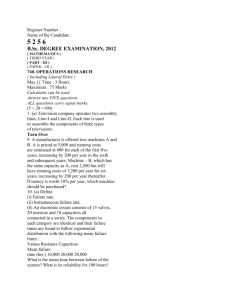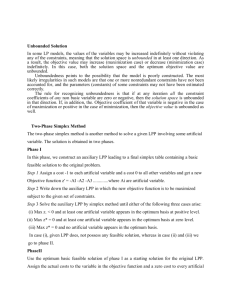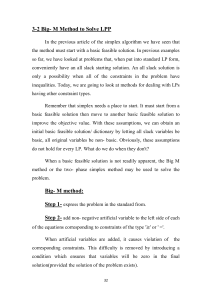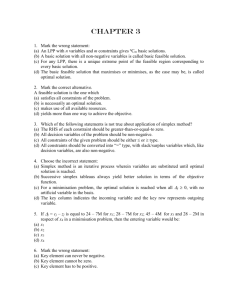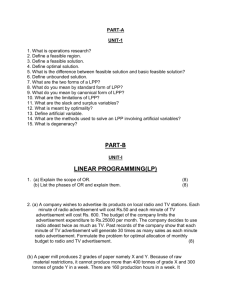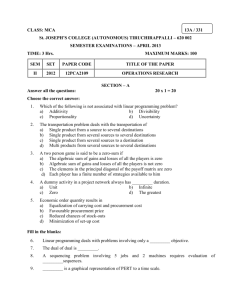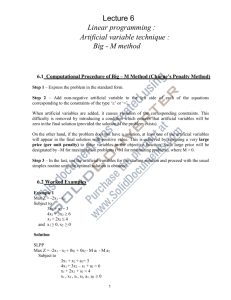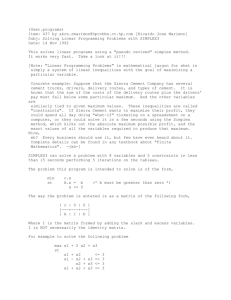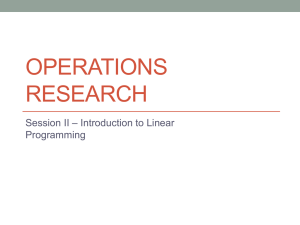Linear programming : Artifical variable technique
advertisement
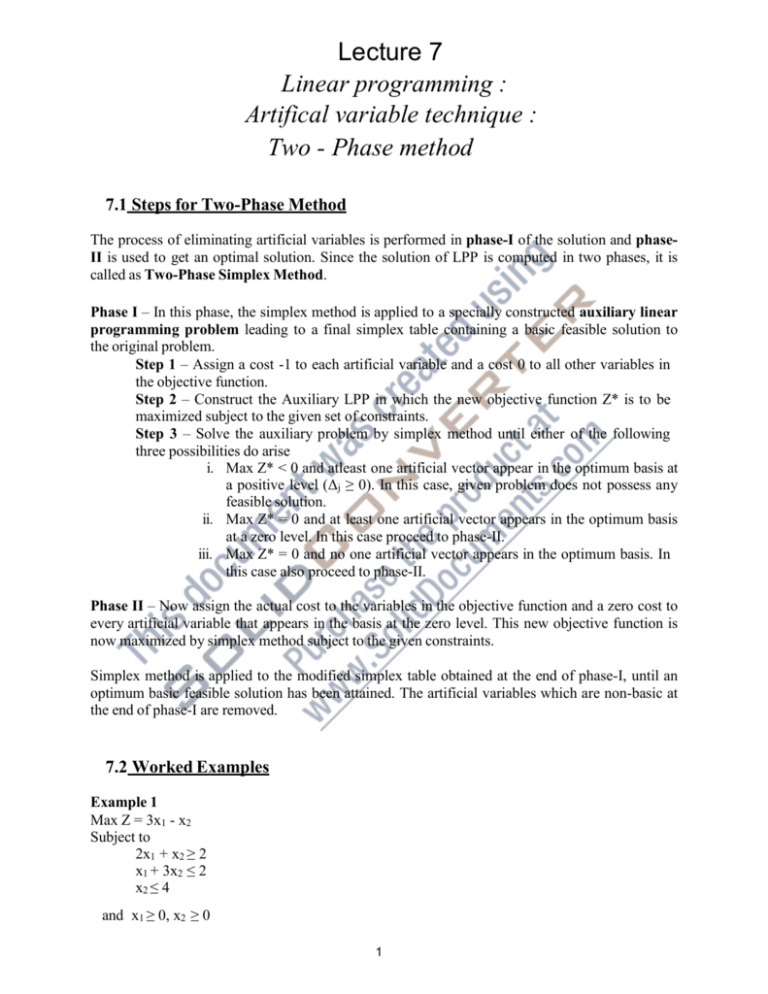
Lecture 7 Linear programming : Artifical variable technique : Two - Phase method 7.1 Steps for Two-Phase Method The process of eliminating artificial variables is performed in phase-I of the solution and phaseII is used to get an optimal solution. Since the solution of LPP is computed in two phases, it is called as Two-Phase Simplex Method. Phase I – In this phase, the simplex method is applied to a specially constructed auxiliary linear programming problem leading to a final simplex table containing a basic feasible solution to the original problem. Step 1 – Assign a cost -1 to each artificial variable and a cost 0 to all other variables in the objective function. Step 2 – Construct the Auxiliary LPP in which the new objective function Z* is to be maximized subject to the given set of constraints. Step 3 – Solve the auxiliary problem by simplex method until either of the following three possibilities do arise i. Max Z* < 0 and atleast one artificial vector appear in the optimum basis at a positive level (Δj ≥ 0). In this case, given problem does not possess any feasible solution. ii. Max Z* = 0 and at least one artificial vector appears in the optimum basis at a zero level. In this case proceed to phase-II. iii. Max Z* = 0 and no one artificial vector appears in the optimum basis. In this case also proceed to phase-II. Phase II – Now assign the actual cost to the variables in the objective function and a zero cost to every artificial variable that appears in the basis at the zero level. This new objective function is now maximized by simplex method subject to the given constraints. Simplex method is applied to the modified simplex table obtained at the end of phase-I, until an optimum basic feasible solution has been attained. The artificial variables which are non-basic at the end of phase-I are removed. 7.2 Worked Examples Example 1 Max Z = 3x1 - x2 Subject to 2x1 + x2 ≥ 2 x1 + 3x2 ≤ 2 x2 ≤ 4 and x1 ≥ 0, x2 ≥ 0 1 Solution Standard LPP Max Z = 3x1 - x2 Subject to 2x1 + x2 – s1+ a1= 2 x1 + 3x2 + s2 = 2 x2 + s3 = 4 x1 , x2 , s1, s2, s3,a1 ≥ 0 Auxiliary LPP Max Z* = 0x1 - 0x2 + 0s1 + 0s2 + 0s3 -1a1 Subject to 2x1 + x2 – s1+ a1= 2 x1 + 3x2 + s2 = 2 x2 + s3 = 4 x1 , x2 , s1, s2, s3,a1 ≥ 0 Phase I Basic Variables a1 s2 s3 x1 s2 s3 Cj → 0 0 0 0 0 -1 CB XB X1 X2 S1 S2 S3 A1 -1 0 0 2 2 4 1 3 1 -1 0 0 0 1 0 0 0 1 1 0 0 Z* = -2 0 1 0 1 0 4 2 1 0 ↑ -2 1 0 0 -1 1/2 5/2 1 1 -1/2 1/2 0 0 0 1 0 0 0 0 1 0 Z* = 0 0 0 0 0 0 X Min ratio XB /Xk 1→ 2 ←Δj X X X ←Δj Since all Δj ≥ 0, Max Z* = 0 and no artificial vector appears in the basis, we proceed to phase II. Phase II Cj → 3 -1 0 2 0 0 Basic Variables x1 s2 s3 XB X1 X2 S1 S2 S3 3 0 0 1 1 4 1 0 0 1/2 5/2 1 0 1 0 0 0 1 5/2 3 5 1 0 1 2 0 0 0 0 1 ←Δj 2 2 4 0 1 0 0 -1/2 1/2 0 ↑ -3/2 0 1 0 0 10 0 3 0 ←Δj Z=3 x1 s1 s3 Min ratio XB /Xk 2→ - CB 3 0 0 Z=6 Since all Δj ≥ 0, optimal basic feasible solution is obtained Therefore the solution is Max Z = 6, x1 = 2, x2 = 0 Example 2 Max Z = 5x1 + 8x2 Subject to 3x1 + 2x2 ≥ 3 x1 + 4x2 ≥ 4 x1 + x2 ≤ 5 and x1 ≥ 0, x2 ≥ 0 Solution Standard LPP Max Z = 5x1 + 8x2 Subject to 3x1 + 2x2 – s1+ a1 = 3 x1 + 4x2 – s2+ a2 = 4 x1 + x2 + s3 = 5 x1 , x2 , s1, s2, s3, a1, a2 ≥ 0 Auxiliary LPP Max Z* = 0x1 + 0x2 + 0s1 + 0s2 + 0s3 -1a1 -1a2 Subject to 3x1 + 2x2 – s1+ a1 = 3 x1 + 4x2 – s2+ a2 = 4 x1 + x2 + s3 = 5 x1 , x2 , s1, s2, s3, a1, a2 ≥ 0 3 Phase I Cj → Basic Variables a1 a2 s3 0 0 0 0 0 -1 -1 Min ratio XB /Xk 3/2 1→ 5 CB XB X1 X2 S1 S2 S3 A1 A2 -1 -1 0 3 4 5 3 1 1 2 4 1 ↑ -6 0 1 0 -1 0 0 0 -1 0 0 0 1 1 0 0 0 1 0 1 -1 0 0 1 1/2 -1/4 1/4 0 0 0 1 0 1 0 0 0 0 0 1 0 1 -2/5 1/10 3/10 -1/2 1/5 -3/10 1/10 0 0 0 1 0 ←Δj X X X X X X X 0 0 0 0 X X ←Δj a1 x2 s3 Z* = -7 -1 1 0 1 0 4 x1 x2 s3 Z* = -1 0 2/5 0 9/10 0 37/10 Z* = 0 -4 5/2 1/4 3/4 ↑ -5/2 1 0 0 0 X X X ←Δj 2/5→ 4 16/3 Since all Δj ≥ 0, Max Z* = 0 and no artificial vector appears in the basis, we proceed to phase II. Phase II Cj → Basic Variables x1 x2 s3 5 8 0 0 0 CB XB X1 X2 S1 S2 S3 5 8 0 2/5 9/10 37/10 1 0 0 0 1 0 -2/5 1/10 3/10 0 0 1 s2 x2 s3 Z = 46/5 0 2 8 3/2 0 7/2 0 5 3/2 -1/2 0 0 1 0 0 0 0 1 ←Δj 7→ 7 3 1 -1 0 0 1 0 0 1 0 0 0 2 1/2 2 ←Δj s2 x2 s1 Z = 12 0 16 8 5 0 7 -6/5 -2 -1/2 1/2 ↑ -4 0 0 1 1/5 -3/10 1/10 ↑ -7/5 1 0 0 Min ratio XB /Xk 2→ 37 Z = 40 3 0 0 0 4 Since all Δj ≥ 0, optimal basic feasible solution is obtained Therefore the solution is Max Z = 40, x1 = 0, x2 = 5 4
